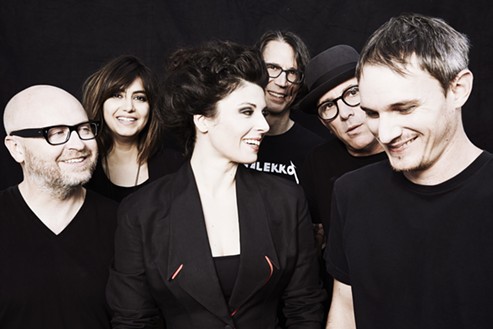Most famous as the frontman for prog-leaning hard rock acts Tool and Perfect Circle, Ravenna native Maynard James Keenan gets his multimedia on with Puscifer, a project that leans more toward performance art than rock. The group performs at 7:30 p.m. on Monday, April 4, at the Akron Civic Theatre.
While Puscifer’s 2007 debut features different songs and ideas that Keenan had accumulated for over a decade, Conditions of My Parole and the just-released Money Shot serve as more cohesive records that represented the band’s transformation into a “full-fledged, Vaudevillian touring troupe.” Keenan recently phoned us from his Verde Valley home in Arizona where he runs a winery.
“During harvest, I’m here for a solid three months,” says Keenan when asked about how much time he spends at the winery. “I don’t really tour that much, just on and off. I’ve been here since late ’95, early ’96. The tow is a little busier now than it was. It’s a pretty small town. A lot of it has fallen down because of infrastructure issues back in the day, but it’s well stabilized at this point. [Living here] has influenced my music. Whatever touches you daily is going to affect your art.”
Puscifer started in the mid-’90s in small clubs around L.A.
“It was a variety show with a lot of sketch comedy,” says Keenan. “We would close one night, then there would be no music one night and then the third night would maybe be Tenacious D.”
Keenan didn’t take the band on the road until 2009. The live show has turned into a theatrical affair. Keenan often parks on Airstream trailer on stage and creates a Southwestern motif with the use of props.
“Everything about Puscifer presents some juxtaposition between incredibly meaningful seriousness and hilarity,” says singer Carina Round in a separate phone interview. “The more Maynard finds the connection between those two, the more comfortable he feels in a way. He’s also contrarian. If he comes up with an idea, and everyone in the room drops their head in their hands and goes, ‘I don’t want to do that,’ that’s the one he wants to do. His satisfaction comes from putting things together that seemingly don’t belong together. It’s not in a way that it’s completely confused and avant-garde. It’s not Dali or anything, but there’s a connection between the sensitivity and the thing that makes you laugh for ten minutes and you don’t know why.”
Money Shot opens with “Galileo,” a hypnotic song that features soft vocals, percolating synths and percussion and heavy bass riffs.
“You can think the song is about one thing and [Keenan] can explain it to you and it’s about something different,” says Round when asked about the album. “I thought ‘Galileo’ was about Galileo. Then, [Keenan] told me what it was about, and I was completely confused. It is about Galileo but, because it’s Maynard, it’s more rooted in his journey. That’s what makes him such a great lyricist and artist. He can make those connections and make people feel like it’s their journey too. I feel like there’s access to a more vulnerable place, just from listening to the album and the lyrics. I feel like he’s at a different stage of appreciation in his life. That’s what I get from the lyrics. Some of the songs are just hilarious. Sometimes, it’s hard to sing without laughing. People listen to it and get offended. He’s a funny person. He subconsciously makes people question what they’re feeling. It’s weird and funny and they don’t know how they should take it.”
Standing on the rim of the Grand Canyon inspired “Grand Canyon,” one of the more direct tunes on the album.
“The song started with that movie Grand Canyon,” says Keenan. “Seeing that panoramic shot of them standing at the edge made me want to go check it out. I think the best way to see it is to be moving. That movement gives you that perspective of just how deep it is. It’s really a fascinating and humbling experience.”
“Simultaneous” recounts a story about a person that Keenan met in Michigan, and “The Arsonist” makes references to the cartoon characters Beavis and Butt-Head. The cultural references run a rather wide gamut on the record.
“It’s all just colors on a palette,” says Keenan. “It’s a little open to interpretation but there are stories attached that resonate on certain levels. The cultural references certainly help provide anchors and some guidance but it’s basically an emotional palette.
Keenan says he doesn’t mind that the band might meet the expectations of fans who like his other projects, arguably bands that rock harder than Puscifer and appeal to a metal audience.
“It’s like anything,” he says. “People have a lot of expectations about what it’s going to be. They expect it’s going to be like other bands. But it’s not. It’s a stage presentation. There’s a bow at the end as the curtain closes metaphorically speaking. It’s more of an all-encompassing multimedia presentation. It’s somewhere between my other musical acts and The Book of Mormon, for lack of a better explanation.”


